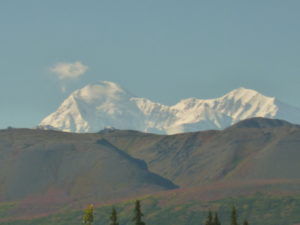
On June 7th, 1913, Hudson Stuck, an Alaskan missionary, led the first successful ascent of Mt. McKinley, the highest point on the American continent at 20,320 feet.
Stuck, an accomplished amateur mountaineer was born in London in 1863. After moving to the United States, in 1905 he became Archdeacon of the Episcopal Church in Yukon, Alaska, where he was an admirer of Native Indian culture and traveled Alaska’s difficult terrain to preach to villagers and establish schools.In the exercise of his duties as Archdeacon, Stuck had travelled throughout the interior of Alaska, both winter and summer, almost continuously since 1904. Again and again, the splendid vision of the greatest mountain in North America had spread before his eyes, and left him each time with a keener longing to enter its mysterious vastness and scale its lofty peaks. Seven years ago, writing in The Spirit of Missions of a view of the mountain from the Pedro Dome, in the neighborhood of Fairbanks, he said: “I would rather climb that mountain than discover the richest gold-mine in Alaska.” (paraphrased from Stuck’s “The Ascent of Denali” published in e-book format by The Gutenberg Project.)
In preparation for the climb, Stuck had ordered supplies from Seattle, but only half arrived. Stuck described the ice-axes as “ridiculous gold-painted toys with detachable heads and broomstick handles…the points splintered the first time they were used.” Additional money was needed – from a budget of $1,000 – to have axes, crampons and silk tents made in Fairbanks. The heavy regulation alpine boots he ordered arrived in sizes too small and were useless. Stuck bought rubber soled snow packs and attached leather soles and nails. The men also wore large size moccasins along with “five pairs of socks.”
In March 1913, the adventure-seeking Stuck set out from Fairbanks for Mt. McKinley with three companions, Harry Karstens, co-leader of the expedition, Walter Harper, whose mother was a Native American, and Robert Tatum, a theology student. Their arduous journey was made more challenging by difficult weather and a fire at one of their camps, which destroyed food and supplies. However, the group persevered and on June 7, Harper, followed by the rest of the party, was the first person to set foot on McKinley’s south peak, considered the mountain’s true summit. (In 1910, a group of climbers had reached the lower north peak.)

Walter Harper was the first to place his foot upon the summit.
“The tent-pole was used for a moment as a flagstaff while Tatum hoisted a little United States flag he had patiently and skillfully constructed in our camps below out of two silk handkerchiefs and the cover of a sewing-bag. The pole was put to its permanent use. It had already been carved with a suitable inscription, and now a transverse piece, already prepared and fitted, was lashed securely to it and it was planted on one of the little snow turrets of the summit – the sign of our redemption, high above North America.” (from Ascent of Denali, page 105)
They also erected a six-foot high cross at the summit.
Stuck referred to the mountain by its Athabascan Indian name, Denali, meaning “The High One.” In 1889, the mountain had been dubbed Densmores Peak, after a prospector named Frank Densmore. In 1896, it was renamed in honor of Senator William McKinley, who became president that year.
Mount McKinley National Park was established as a wildlife refuge in 1917. Harry Karstens served as the park’s first superintendent. In 1980, the park was expanded and renamed Denali National Park and Preserve. Encompassing 6 million acres, the park is larger than Massachusetts.
Stuck continued to urge Alaska Native youths in their education, helping arrange scholarships and sponsors for education in the Lower 48. He worked as an Episcopal priest in Alaska for the rest of his life, serving both Alaska Natives and American settlers. Like many other missionaries, he never married. He died of pneumonia in Fort Yukon on October 10, 1920. By his request, he was buried in the native cemetery there.
Today, over 1,000 hopeful climbers attempt to scale Mt. McKinley each year, with about half of them successfully reaching their goal.
Source: www.history.com, www.wikipedia.com, www.ciri.com, www.gutenberg.org
People reacted to this story.
Show comments Hide comments[…] Hudson Stuck: First Successful Ascent Of Mt. McKinley – The …Jul 11, 2016 – On June 7th, 1913, Hudson Stuck, an Alaskan missionary, led the first successful ascent of Mt. McKinley, the highest point on the American … […]